

Damion Smy
Hyundai teases Staria EV ahead of likely January reveal
2 Minutes Ago
Keen to get big performance from the smallest Mini Hatch? The John Cooper Works is a distinctive hot hatch, but it's not cheap.
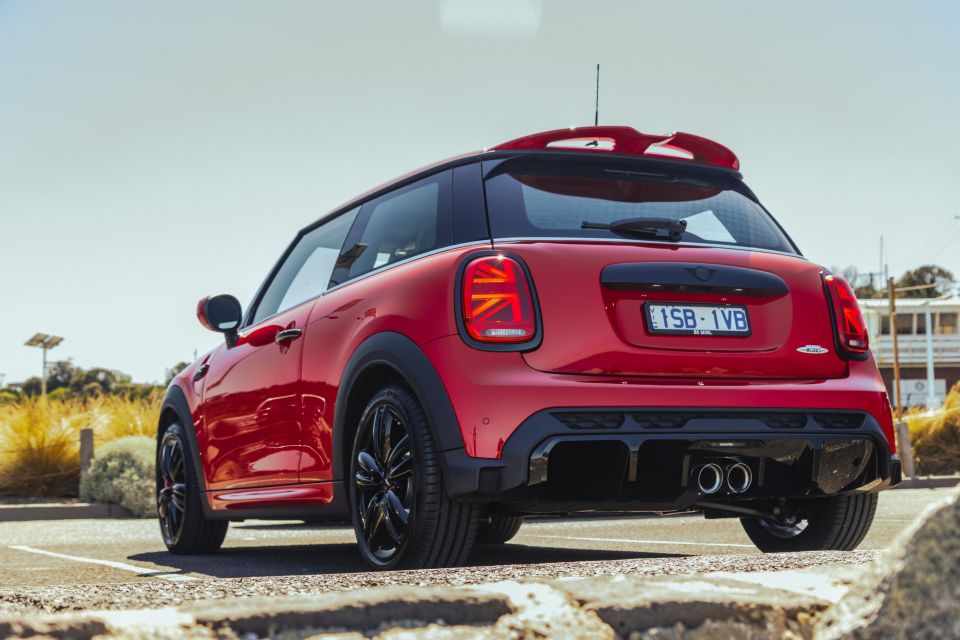


Contributor
New from
$54,850
excl. on-roads

Contributor
New from
$54,850
excl. on-roads


Contributor
New from
$54,850
excl. on-roads

Contributor
New from
$54,850
excl. on-roads
Quickly see how this car stacks up against its competition. Select any benchmark to see more details.
Where expert car reviews meet expert car buying – CarExpert gives you trusted advice, personalised service and real savings on your next new car.
There’s only one badge you want to see if you’re a Mini fan who likes to go fast: John Cooper Works.
Named after British racer John Cooper, the badge has been applied to the hottest Mini hatches since BMW saved the brand from the flaming wreckage of Rover.
Like everything else New Mini, what the JCW badge stands for has grown and changed over the last two decades.

Before it was bought by BMW, the John Cooper Works garage was a third-party providing power packs for the Mini range. Its first kit upped grunt in the base Cooper to 95kW, its second was a package for the supercharged Cooper S bumping power to 149kW.
The first factory Mini John Cooper Works came about in 2009, with 156kW of power and performance goodies such as Brembo brakes. Since then the JCW range has grown to include the Countryman and Clubman, and the engine in even the smallest JCW Hatch now cranks out 170kW and 320Nm.
They’re pretty serious numbers, backed by a pretty serious price once on-road costs are added into the mix.
Has the amount of fun on offer risen in step with the price and power, or has Mini finally stretched its John Cooper Works formula to the max?
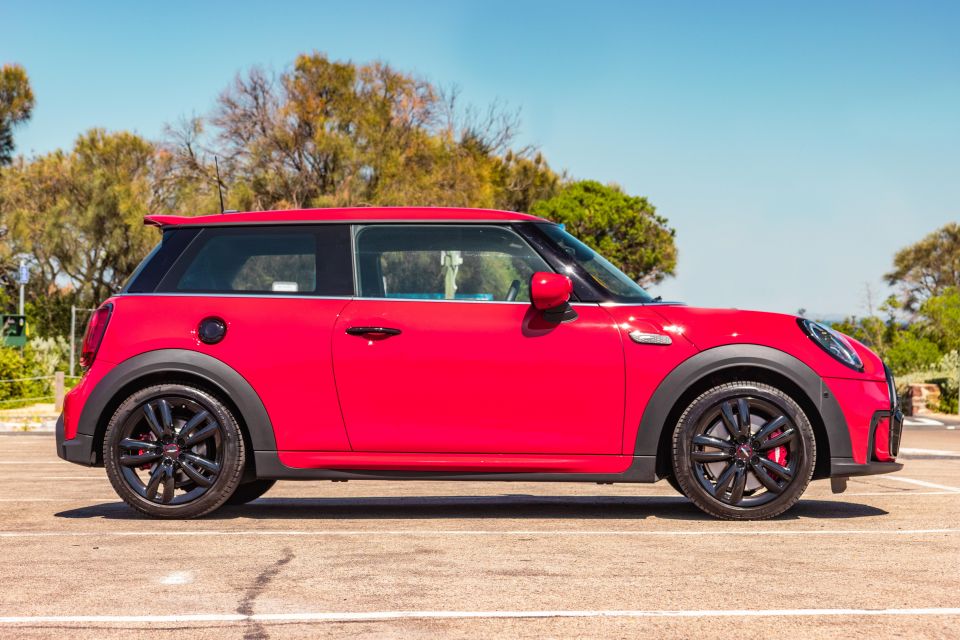
The Mini John Cooper Works range kicks off with the car on test here, the JCW Essential Hatch, priced at $54,850 before on-road costs.
If you’re not concerned with performance though, you can get into a three-cylinder, three-door Mini Cooper Classic from $37,500 before on-road costs.
Given its diminutive size, direct rivals around the $55,000 mark are hard to come by.
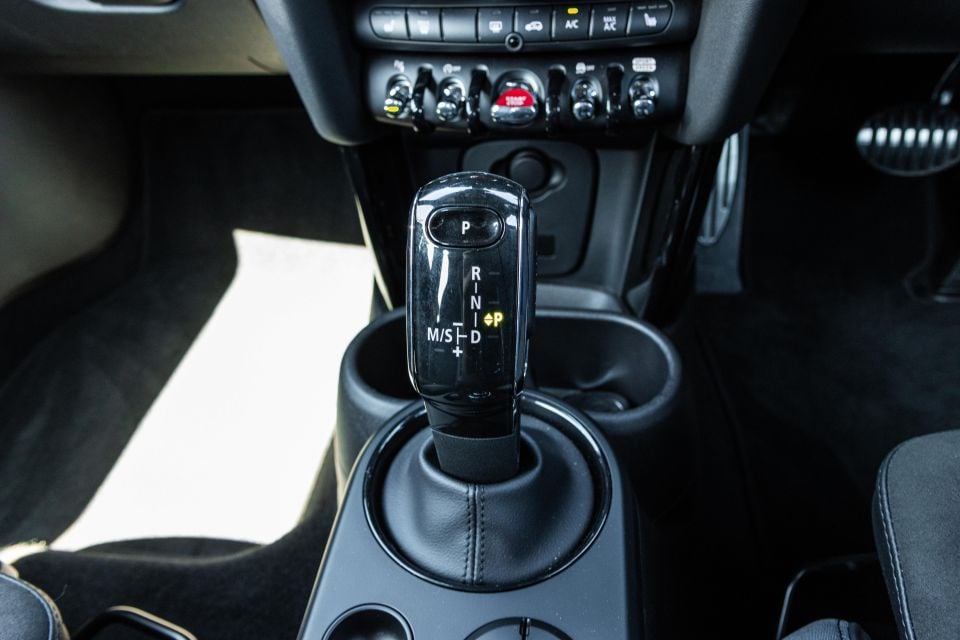
If you’re willing to consider hot hatches with five doors, the Mini JCW faces off with the Volkswagen Golf GTI ($53,100), and the Renault Megane RS Trophy auto ($56,990).
It’s also knocking on the door of the BMW 128ti ($56,900) with which it shares its base engine and platform.
2022 Mini John Cooper Works Hatch pricing:
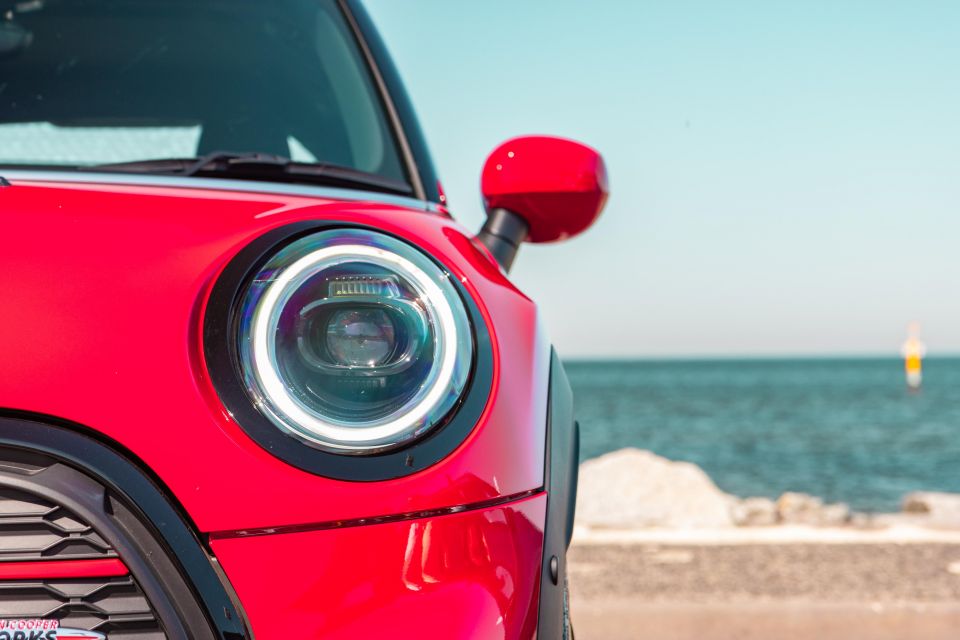
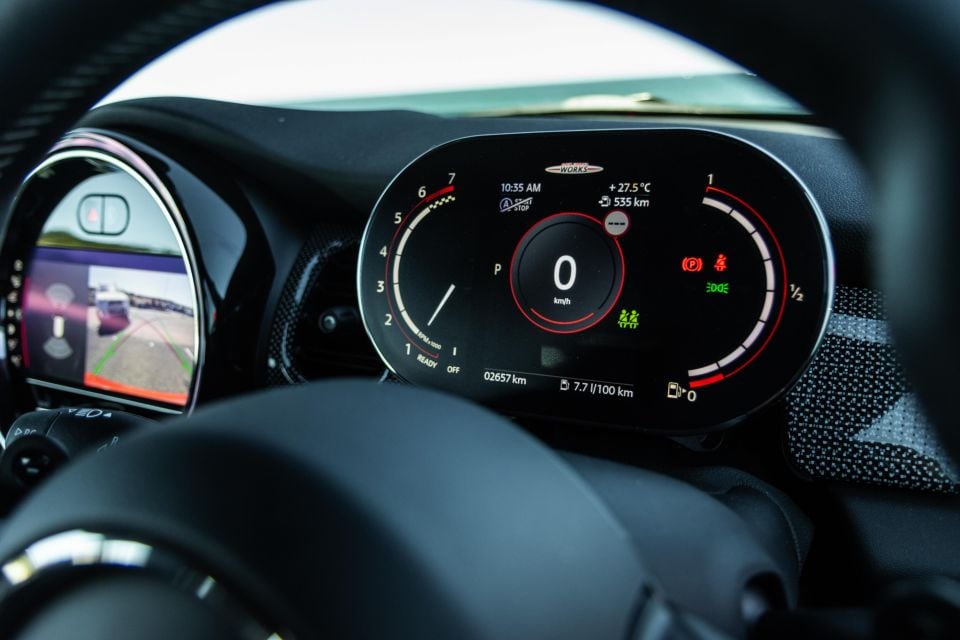
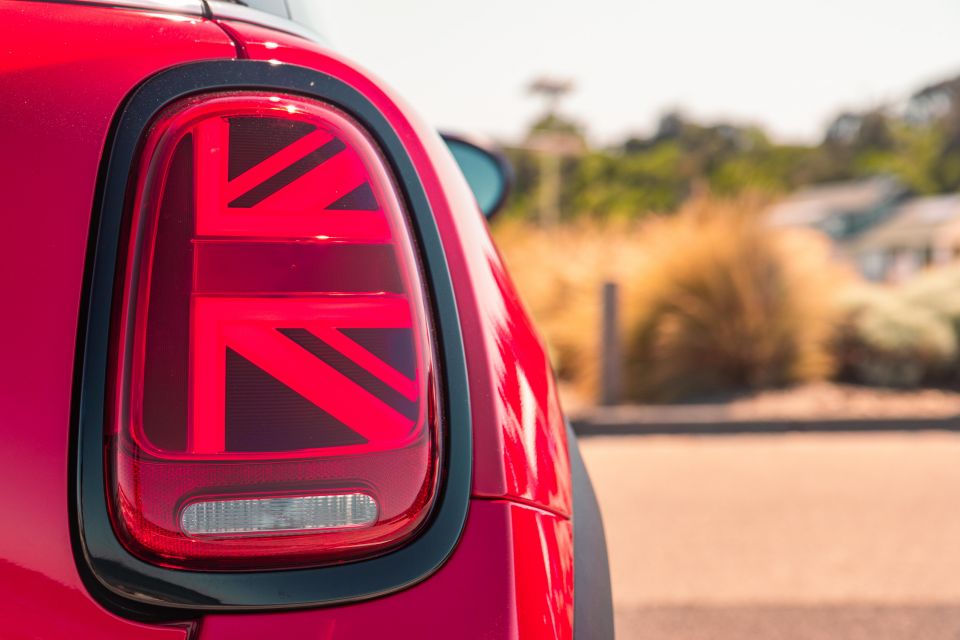
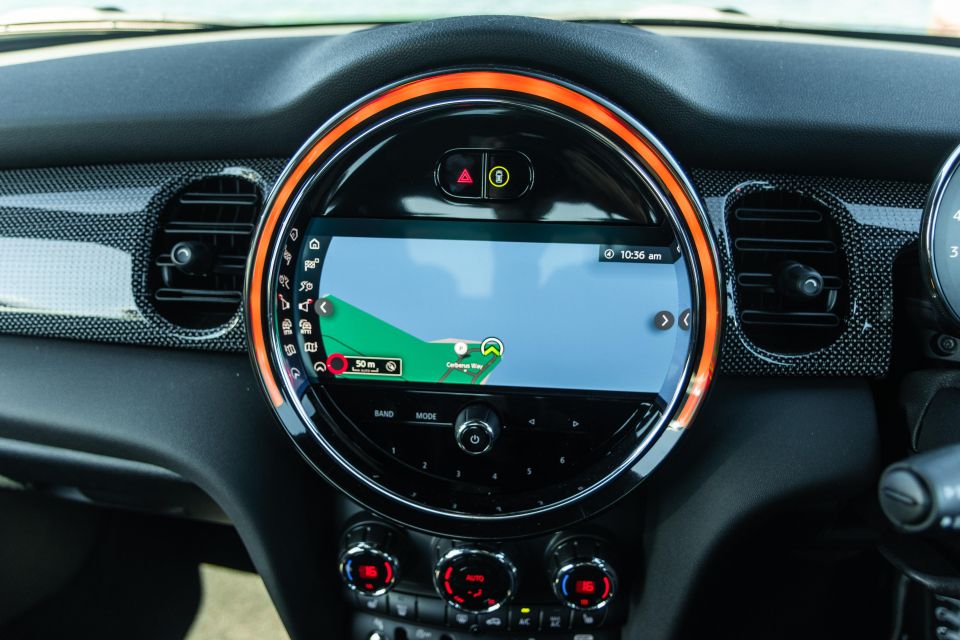
Buy your new car without the stress. It's fast, simple and completely free.

Great service from Travis and team, second time I have used this business would not hesitate to recommend them to anyone
Craig C.
Purchased a Ford Ranger in Sunshine Coast, QLD
CarExpert helped Craig save thousands on his Ford Ranger, now let us save you on your next new car.
Find a dealUnlike Mini models past, there aren’t millions of options for the JCW Essential. It’s designed to be the equivalent of the Pure trim rolling out across the BMW range, offering plenty of performance at a more affordable price by ignoring what some people would consider unnecessary luxury features.
Over lower models in the range, it gains:

That’s atop the following standard features:
Paying more for the JCW Classic gets you a head-up display, adaptive suspension, a Harman/Kardon sound system, and leather upholstery, while the range-topping Mini Yours gains adaptive LED headlights and a panoramic sunroof.
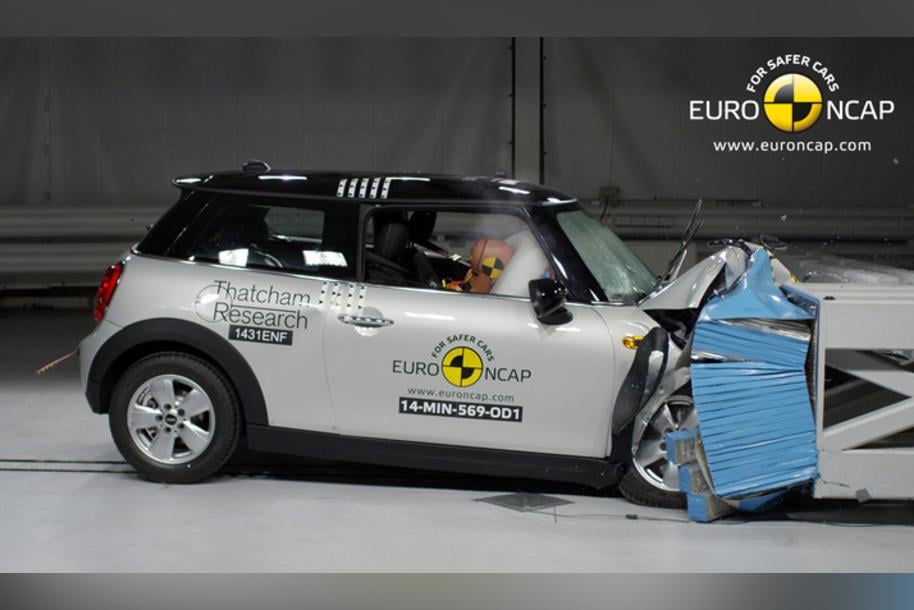
The Mini 3-Door Hatch has a four-star safety rating from ANCAP, based on testing conducted in 2014.
It received a frontal offset score of 14.60 out of 16, a side impact score of 12.19 out of 16, pedestrian and whiplash protection ratings of Good and Acceptable, respectively, and an overall score of 31.78 out of 37.
All 2022 Mini Hatch and Convertible models come standard with the following:
Blind-spot monitoring, rear cross-trafic alert, and high-speed autonomous emergency braking are all notable omissions.
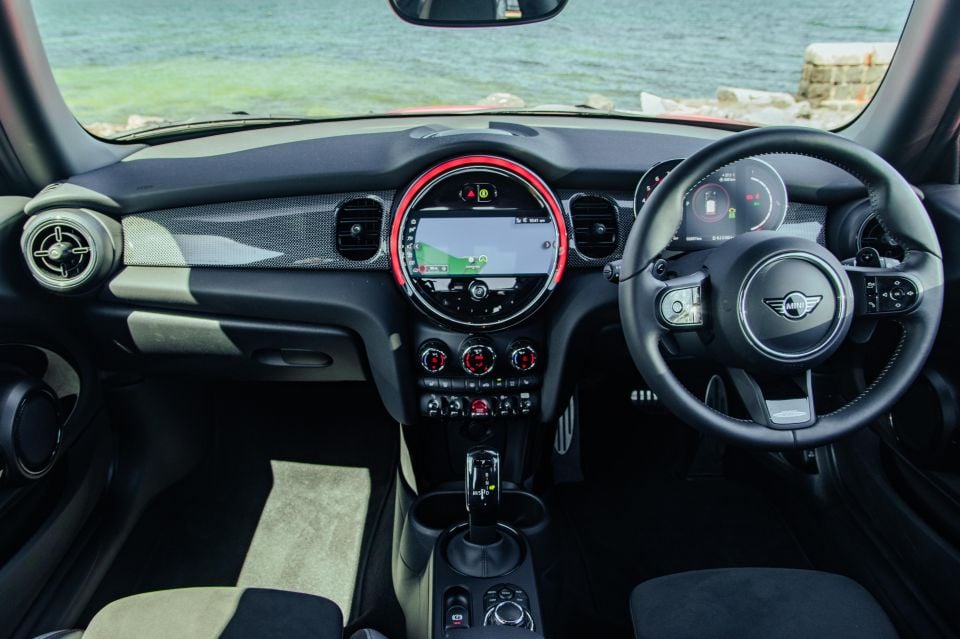
Although it was updated for 2021, the JCW is familiar from behind the wheel.
There’s lots of circles, and lots of interesting design flourishes, but not much in the way of storage (or rear-seat, or boot-) space.
The driver and passenger sit in comfortable bucket-style seats with heating, and there’s an impressive range of manual adjustment. That means tall drivers can get comfortable, and short drivers can get high enough to see out without the help of phone books.
With its near-vertical windscreen, the view out of the Mini JCW is still unique. It’s like looking through a letterbox, while the rear windscreen is almost within touching distance when you turn around.
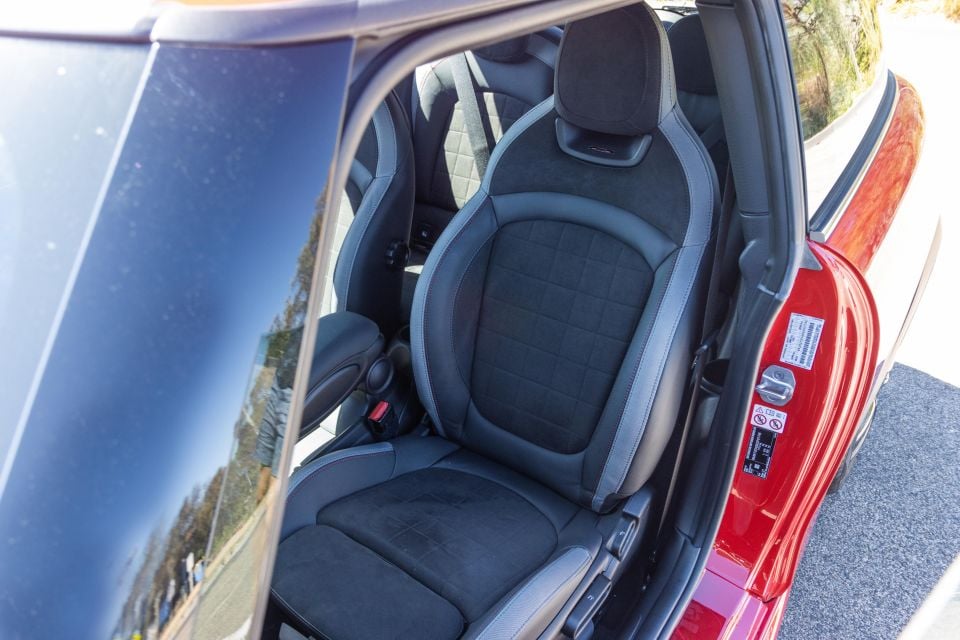
Facing the driver is a fat, leather-trimmed steering wheel and a new semi-digital instrument display. It’s been nicked from the Mini Electric, and squeezes a 5.5-inch vertical display between a more traditional rev counter and fuel gauge to offer you a big digital speedo… but not much else.
Given even the Hyundai i20 N or Volkswagen Polo GTI offer bigger, more versatile dials, the display in the JCW looks and feels old. It’s nudging twice the price of both those cars, and really should be better.
Sitting in the middle of the dashboard is an 8.8-inch touchscreen infotainment system running a reskinned take of the iDrive 6 system being gradually phased out across the BMW range.
With plenty of bright colours and bubbly animations, it’s in keeping with the fun and youthful vibe Mini is chasing – and with BMW logic and plenty of processing power, it’s fast and easy to use. Although it supports touch inputs, you can also use a small rotary dial on the transmission tunnel to flick through its menus.

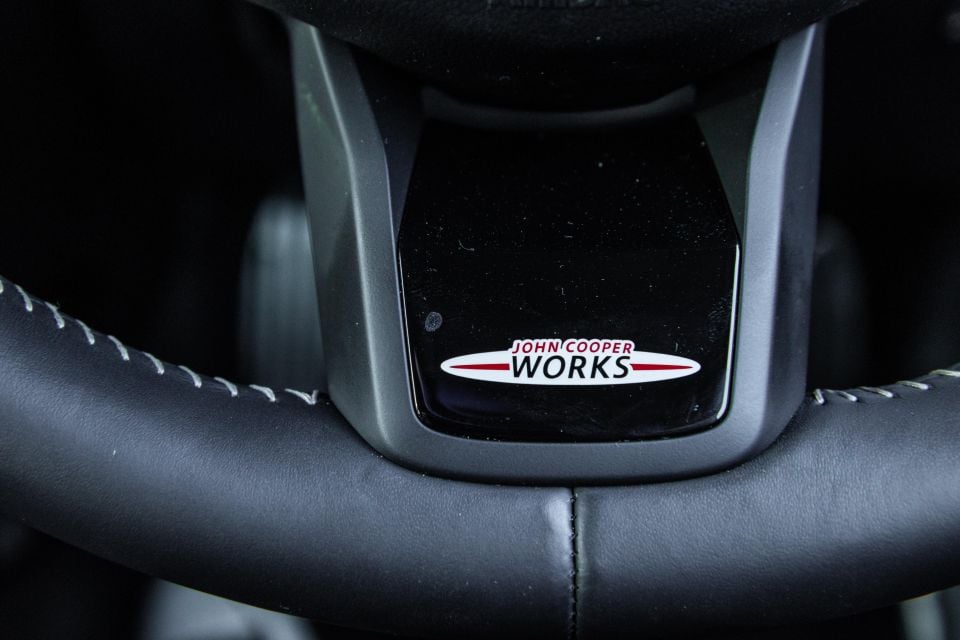
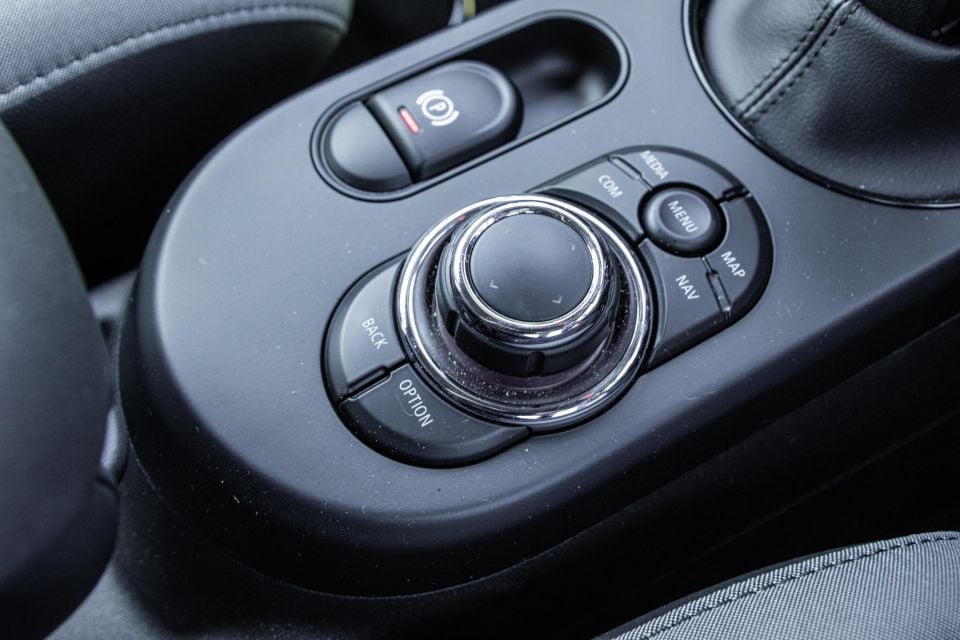
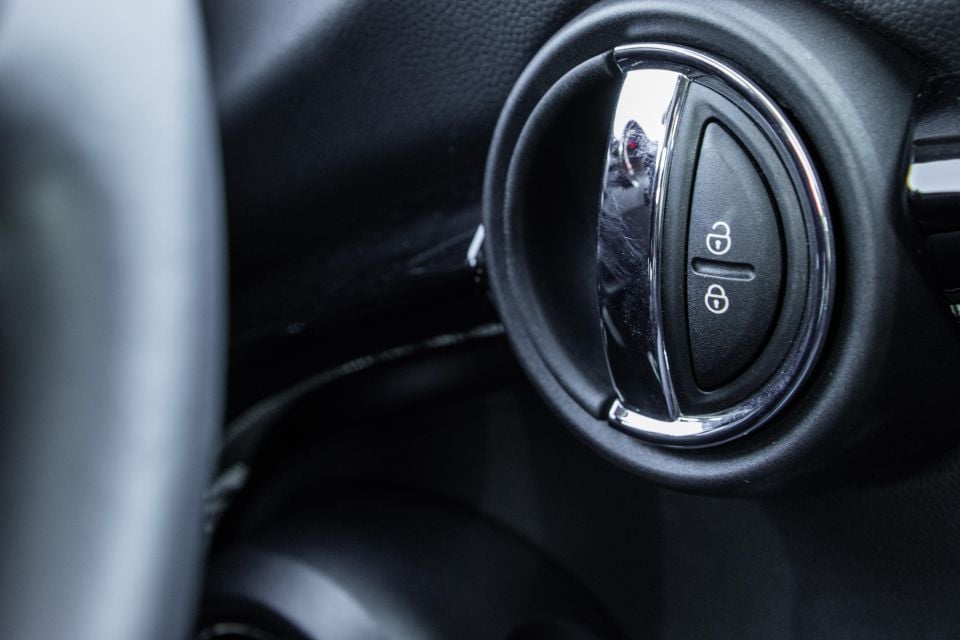
There’s wireless smartphone mirroring, but the inbuilt mapping is among the best in the business, and Spotify is integrated into the system if your phone is connected using Bluetooth.
Along with the digital dash, the 2021 update brought about a new gloss black panel below the screen that attracts fingerprints at a terrifying rate. It’s a step backwards, as are the new gloss black buttons on the steering wheel.
Very little has changed elsewhere, which means you still get some cool-looking toggle switches, physical climate controls, and an LED light ring around the centre screen that changes colour depending your drive mode, or when you change the temperature.
It’s still a cool place to be, although Mini hasn’t done much to evolve its design language since 2003. It’s also worth mentioning that, aside from the seats and steering wheel, the cabin isn’t exactly a soft-touch paradise. There are plenty of scratchy surfaces that feel out of place in a city hatch priced north of $50k.


Storage space has always been a weak point for Mini, and the latest JCW does nothing to change it. The wireless phone charger in the central armrest doesn’t fit a plus-sized iPhone, the slot at the base of the dash is oddly-shaped, and the door pockets will barely fit a sunglasses case.
Speaking of Mini weaknesses, the rear seats in the three-door are nigh on unusable. Legroom is negligible behind all but the shortest drivers, and getting in requires a decent degree of flexibility. They’re best left for groceries, or people you really don’t like.
Boot space is a claimed 211 litres with the rear seats in place, expanding to 731 litres with the rear seats folded.
There’s no real loading lip, and the boot is nice and flat with its false floor in place, although you can raise the floor in search of more space. You don’t get a spare wheel, but there is a tyre repair kit.
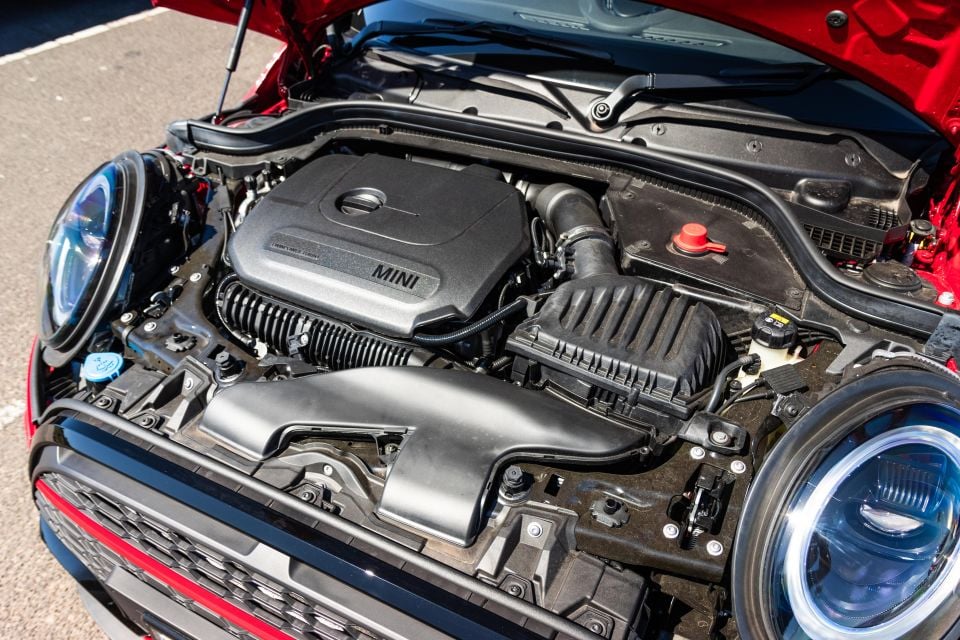
John Cooper Works models are powered by a 2.0-litre four-cylinder turbo petrol engine with 170kW and 320Nm, mated with an eight-speed automatic transmission.
The claimed 100km/h sprint time is 6.1 seconds, and claimed fuel economy is 6.5 litres per 100km. The JCW drinks 95 RON premium unleaded, and has a 40L fuel tank.
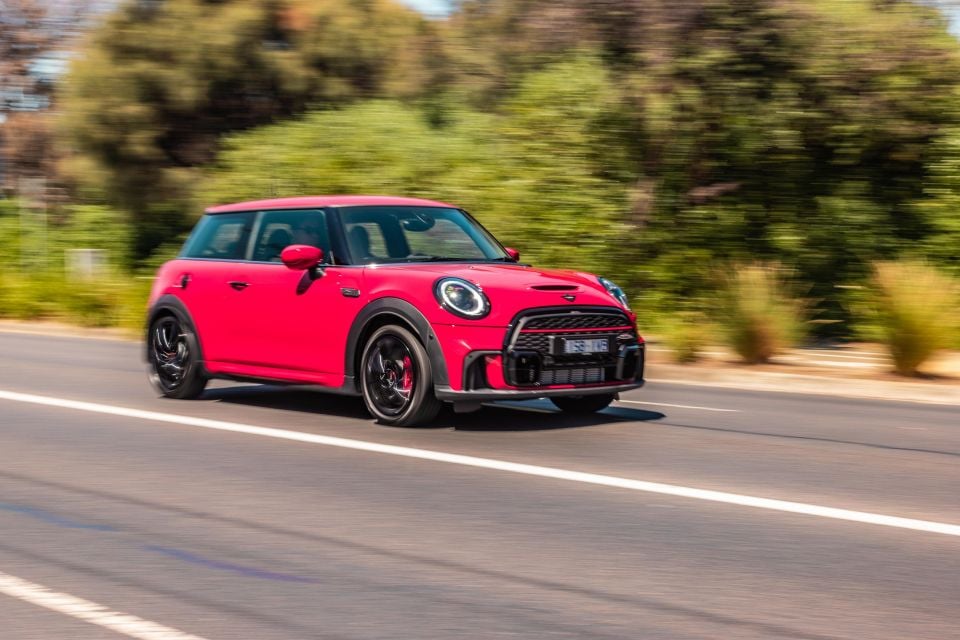
Fire up the JCW and you’re met with a bassy, metallic bark from the central exhaust pipes. It’s a distinctive noise, and it forms a big part of the car’s character when you’re on the move.
With a firm throttle pedal and weighty steering, it’s clear Mini wants the JCW to feel like a serious performance car. Put your foot down and it feels reasonably quick, with a hint of lag giving way to an impressive surge of mid-range shove. There’s no Civic Type R-style surge to the redline; the engine starts to run out of puff towards redline.
The claimed 100km/h sprint time of 6.1 seconds feels accurate in the real world, and has the fastest Mini three-door (short of the sold-out JCW GP) nipping at the heels of larger (but cheaper) cars such as the Hyundai i30 N and Ford Focus ST.
Traction is impressive in the dry, with the combination of sticky Pirelli rubber and fast-acting traction control nixing torque steer and wheelspin in the lower gears.
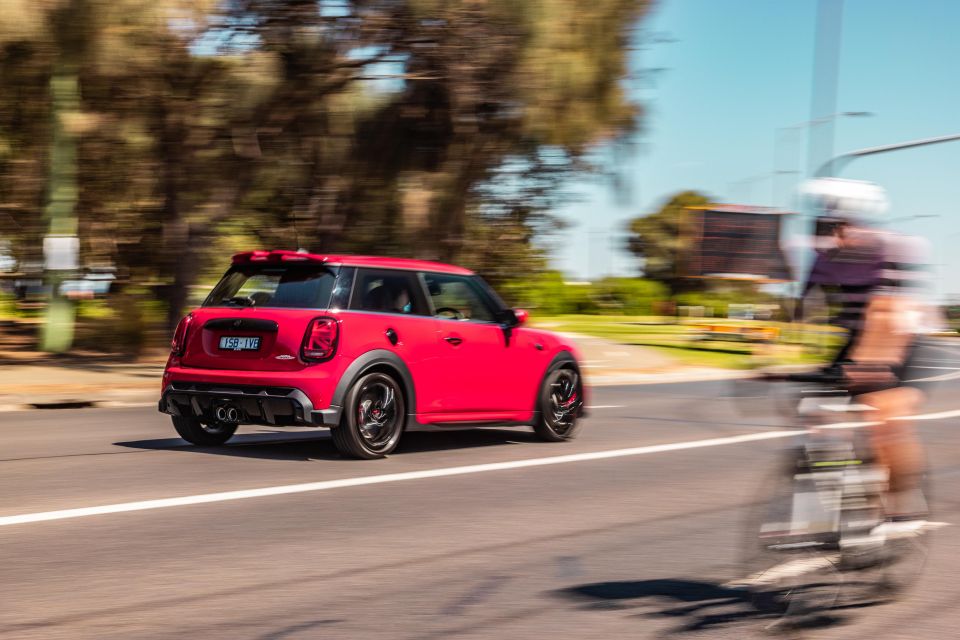
Where expert car reviews meet expert car buying – CarExpert gives you trusted advice, personalised service and real savings on your next new car.
There’s no proper front differential though, which means putting your foot down with a bit of steering lock has the traction control nibbling away and cutting the engine’s torque.
Rather than dragging you out of a corner it feels like the systems are inherently negative, holding you back until they finally decide the front wheels can handle the engine’s full fury. I’d love to see what the limited-slip front differential from the BMW 128ti would do for the JCW, because at the moment the car is slightly hamstrung.
Mini has fitted an eight-speed torque converter which is impressively quick, but lacks that extra bit of snap you get from the latest dual-clutch transmissions. It feels happy in the city, creeping naturally off the mark, and makes some nice noises on full-throttle upshifts when you’re banging through the gears using the cheap-feeling paddle shifters.
With compact proportions, a big engine, and a sporty badge on its boot, you might think the JCW is an absolute rascal in the corners. It feels lively, but some work has gone into toning down some of the liveliness of JCWs past.

It’s fast, and the heavy steering is linked to a front end that goes where you want it to, when you want it to. When you grab it by the scruff of the next it comes alive, and you can bring the rear into play with a heavy lift from the throttle – although it’s more of a gentle rotation than a huge wag of the tail.
Body control is excellent. There’s hardly any roll, with the firm fixed suspension tune keeping the car’s 1200kg-odd mass in check nicely on quick direction changes.
The trade-off is a small hatch that doesn’t settle down on anything but the smoothest roads. It’s constantly moving up and down, jiggling over little pimples in the road surface and clattering into potholes and speed bumps.
Mini has long talked about the go-kart feel of its cars, and it’s not far off the money when it comes to the ride of the JCW on fixed dampers.

Adaptive dampers are offered on higher-spec models, and seem like something worth spending money on if they settle the car down on your daily commute.
Of course, the trade-off for a tiny footprint is the fact you’re able to park in essentially spot, and tight city garages hold no fear. It’s great fun to punt through the urban jungle, with metallic exhaust echoing off concrete pylons and glass skyscrapers.
Although you get adaptive cruise control and lane-keep assist, there’s no blind-spot monitor or rear cross-traffic alert. Given the car’s size and the amount of glass, it’s not the biggest omission in the world – but given the price tag, they should be on the feature list.
There’s compromise inherent in the JCW that’s hard to reconcile. On the one hand, it’s firm and feels sporty all the time. On the other, it don’t know it quite has the strength of character to justify that level of compromise.

Unfortunately, Mini and BMW have stuck with a three-year, unlimited-kilometre warranty instead of moving to a five-year, unlimited-kilometre plan like Mercedes-Benz and Jaguar.
Maintenance is required every 12 months or 20,000km, and Mini offers two different five-year capped-price service plans.
The Basic plan costs $1650 in the John Cooper Works, the Plus plan includes the price of brake pad, wiper blade, and clutch disc and plate replacements, and costs $4320.
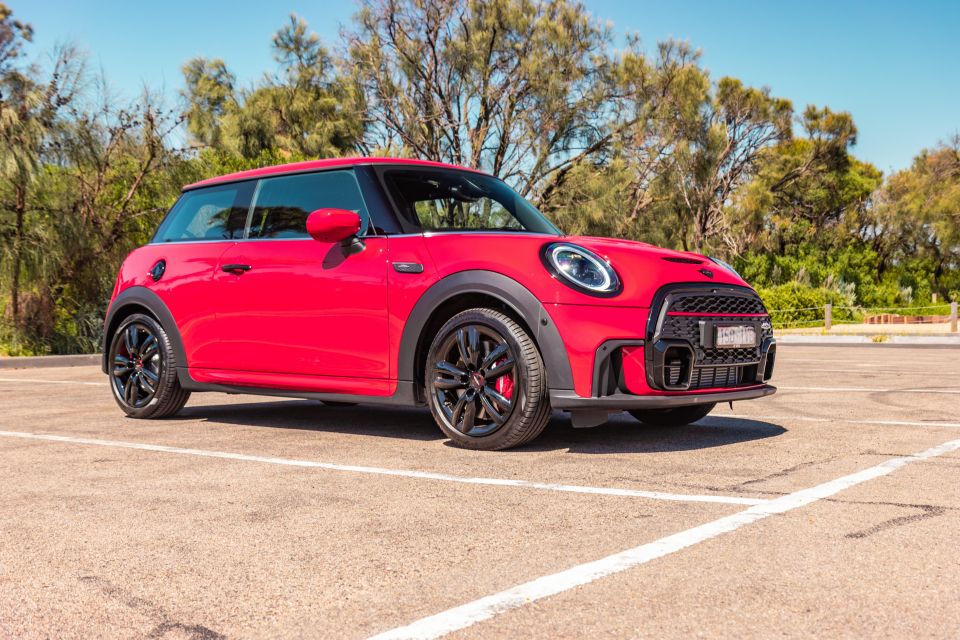
All modern Minis are heart-over-head propositions; cars you buy because you really want one, not need one. The John Cooper Works is no different.
On a spreadsheet, it makes no sense. Bigger, more practical hatches offering similar performance have been lambasted for being overpriced, so it’s hard to make the case for the even the most affordable Mini JCW, the Essential, if budget is a concern.
That wouldn’t matter if the JCW was a charming thing to drive. It certainly has charm, but it doesn’t really work its way under your skin with a distinctive, bombastic character, nor is it as sharp-edged as previous Mini performance cars.
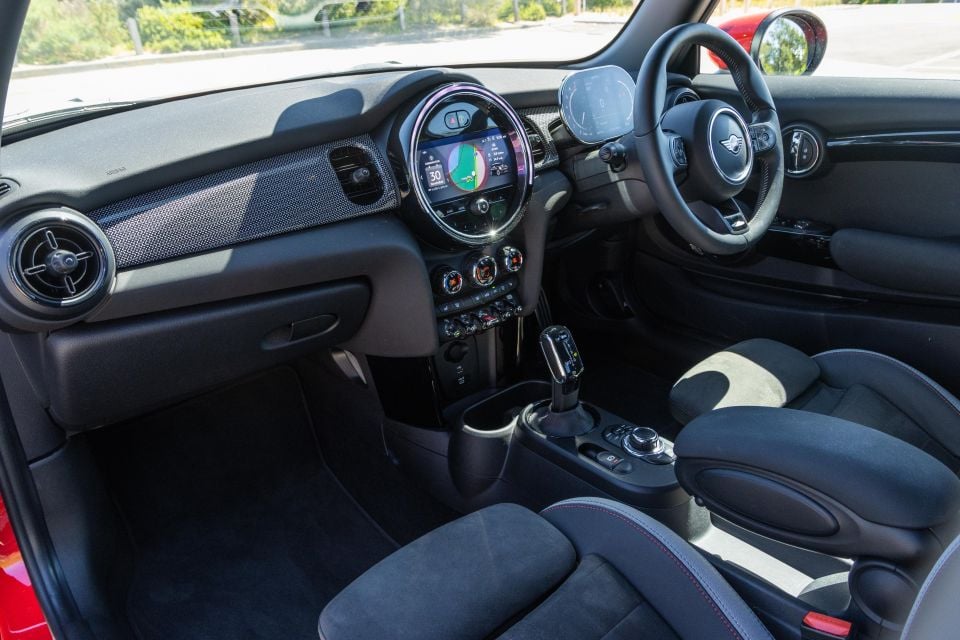
It makes a good noise, but it’s not that quick in a world where the manual Hyundai i20 N does the 100km/h sprint in 6.2 seconds.
What the JCW is, then, is a fast fashion accessory. The modern Mini style has been copied but not bettered, and there’s joy to be found buzzing around the city, darting into gaps like you’re in The Italian Job as the bassy exhaust barks away in the background.
It’s not the most logical car out there, but that doesn’t mean it’s not worth a look if the cutesy styling and bassy burble catch your eye.
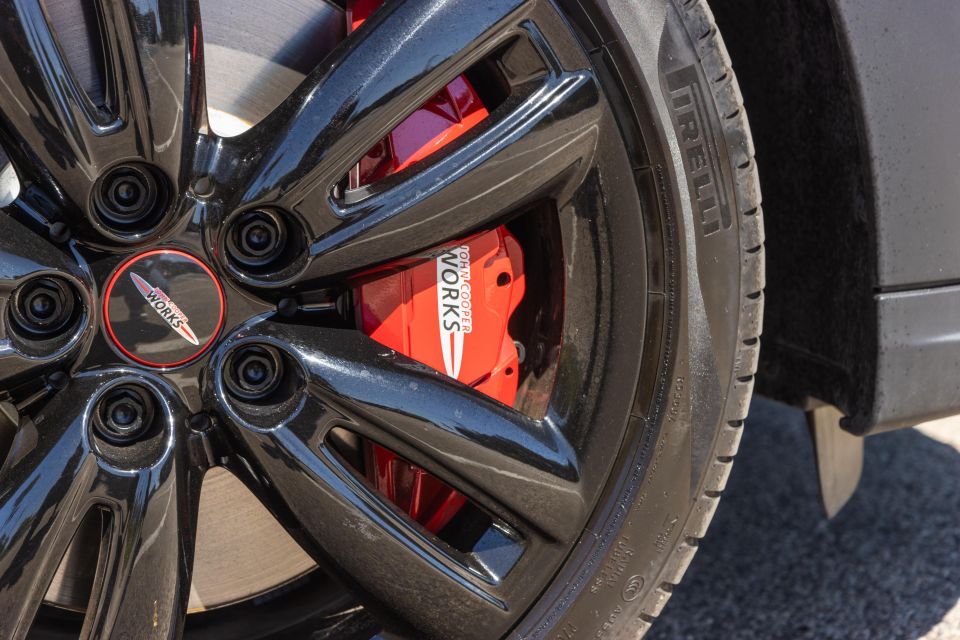
Click the images for the full gallery
MORE: Everything Mini Hatch
Where expert car reviews meet expert car buying – CarExpert gives you trusted advice, personalised service and real savings on your next new car.
Scott Collie is an automotive journalist based in Melbourne, Australia. Scott studied journalism at RMIT University and, after a lifelong obsession with everything automotive, started covering the car industry shortly afterwards. He has a passion for travel, and is an avid Melbourne Demons supporter.


Damion Smy
2 Minutes Ago


Damion Smy
4 Hours Ago


Damion Smy
5 Hours Ago


Damion Smy
6 Hours Ago


Damion Smy
6 Hours Ago


Josh Nevett
6 Hours Ago